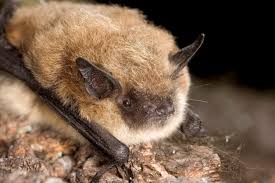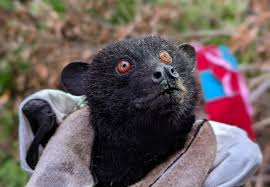These are not all of the bat types but a small group of them as listing all 1,400 would take hours!
Now there are 1,400 speecies of bats some look the same and some do not here are some examples of there unique looks!
This is the Yuma Myotis bat here are a few things about this bat.
The Yuma myotis is found throughout western North America, from British Columbia through Washington, Idaho, and western Montana, southern Wyoming, Colorado, New Mexico, West Texas and into Mexico. Occasionally roosting in mines or caves
these bats are most often found in buildings or bridges. Bachelors also sometimes roost in abandoned cliff swallow nests, but tree cavities are likely the original sites for most nursery roosts. These bats typically forage over water in forested areas.
A study in western Oregon showed that the feeding activity of Yuma myotis was up to eight times higher along forested edges of streams compared to those in logged areas, apparently because the wooded areas contain greater insect diversity. Although Yuma myotis feed predominantly over water, they eat a variety of insects that includes moths, froghoppers, leafhoppers, June beetles, ground beetles, midges, mosquitoes, muscid flies, caddisflies, and crane flies. Yuma myotis are threatened by loss of riparian habitats and the decline in permanent water sources in the southwest.

Image by batcon.org
This is the livingstone's flying fox bat
Here are some information about this bat!
Diet: Livingstone’s fruit bats feed on plants, including pollen, fruit and leaves. Common diet items include kapok fruit and flowers and figs. Individuals in captivity have been observed catching and feeding on insects and insects have been previously reported in wild bat diets.
Appearance: Livingstone’s fruit bats are black or dark brown with large round ears and copper-colored eyes. Also sometimes called Livingstone’s flying fox, they are large bats with wingspans reaching up to 5 feet long.
Habitat: Livingstone’s flying foxes are found only on the islands of Anjouan and Moheli, part of the Comoros islands off the coast of Madagascar. They prefer roosting in native trees, often on steep, south-east facing slopes.
Fun Fact: A recent study using GPS tags to track two Livingstone’s flying foxes found that these bats traveled between 9 and 13 kilometers a day, on average.

Image by batcon.org
This is the eastern red bat.
Here is some data/information about this bat.
Eastern red bats are North America’s most abundant “tree bats.” They are found wherever there are trees east of the Rocky Mountains, from Canada to as far south as central Florida.
Eastern red bats roost in the foliage of deciduous or sometimes evergreen trees. Despite their bright red color, these bats are actually rather cryptic and can appear like dead leaves or pine cones. They are perfectly camouflaged as they hang curled up in the furry membranes of their tails, suspended by a single foot, twisting slightly in the breeze.
For the most part, red bats are solitary, only gathering together to mate and to migrate. Females even roost singly when rearing young. Unlike most bats, eastern red bats often give birth to twins and can have litters of up to five young, though a litter of three pups is average. During the day, pups hold on to their mothers with one foot and a perch with the other. Mothers leave their young alone at night when they go out to feed, but if necessary, they will move them to new locations. Pups begin flying at three to four weeks and are weaned only a few weeks later.
In the summertime, eastern red bats are among the earliest evening fliers, typically feeding around forest edges, in clearings, or around streetlights where they consume predominantly moths. In the fall, they perform long-distance migrations using the same migratory routes along the Atlantic seaboard as many birds. In the late 1800s, there were reports of large migratory bat flocks passing over in the daytime, but no such sightings have been made since. Very little is known about their winter habitat or behavior. In some areas of the southeastern U.S., eastern red bats have occasionally been encountered flying from leaf litter in advance of prescribed burns done during the late fall.
Eastern red bats are known to survive body temperatures as low as 23 degrees F. Their long, silky fur provides extra protection from severe cold, and they also use their heavily furred tail membrane like a blanket, wrapping themselves up almost completely. While in hibernation, red bats respond to subfreezing temperatures by raising their metabolic rate to maintain a body temperature above their critical lower survival limit.

image by batcon.org